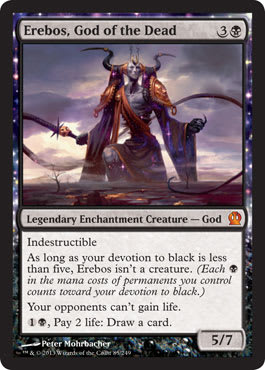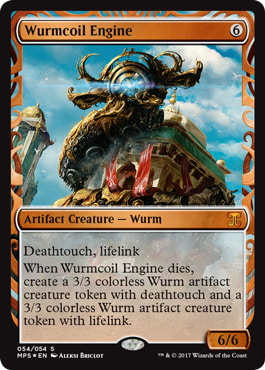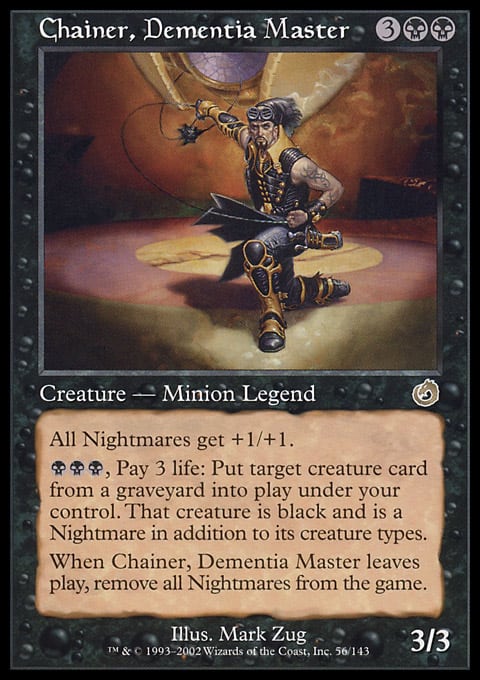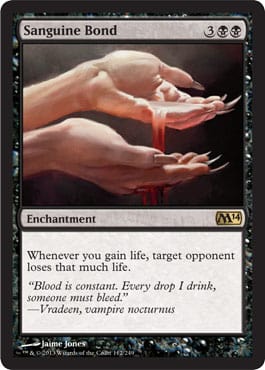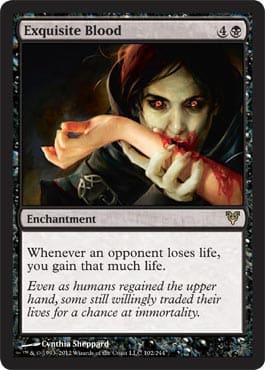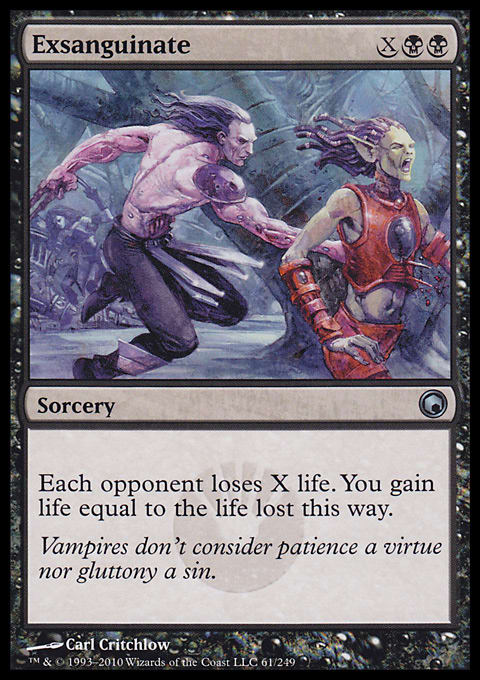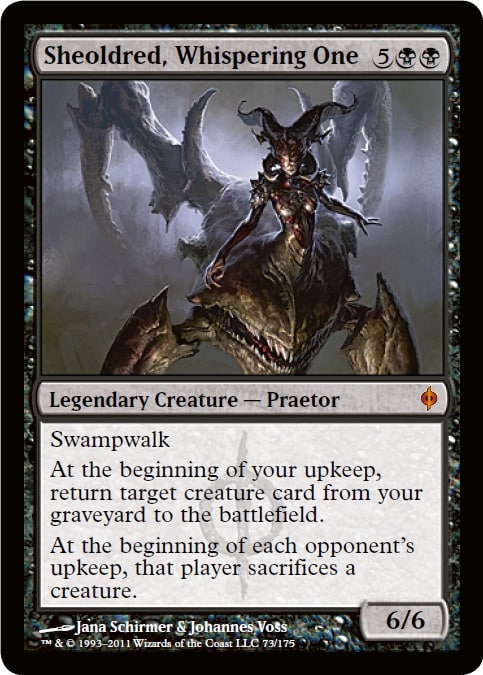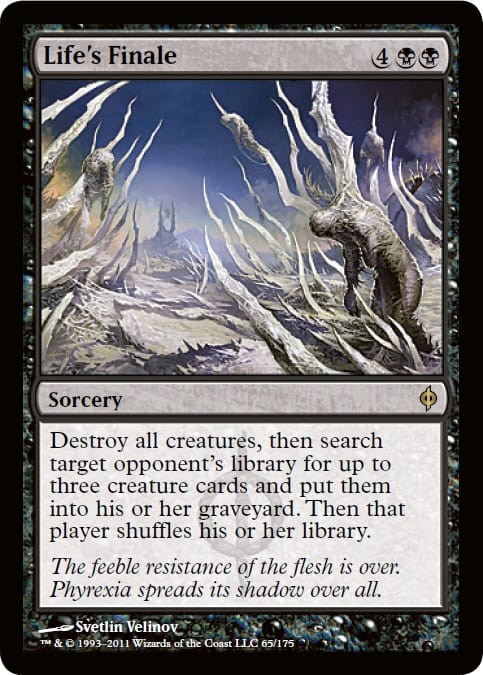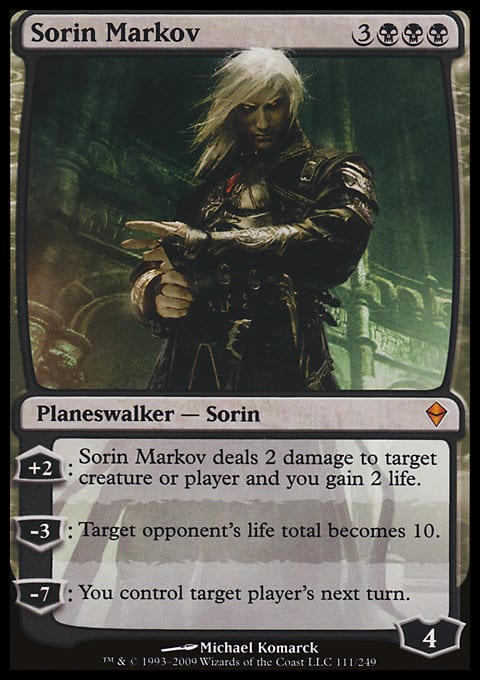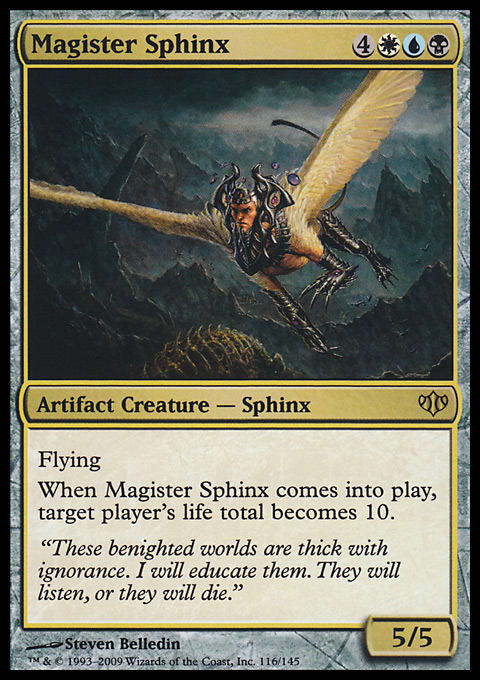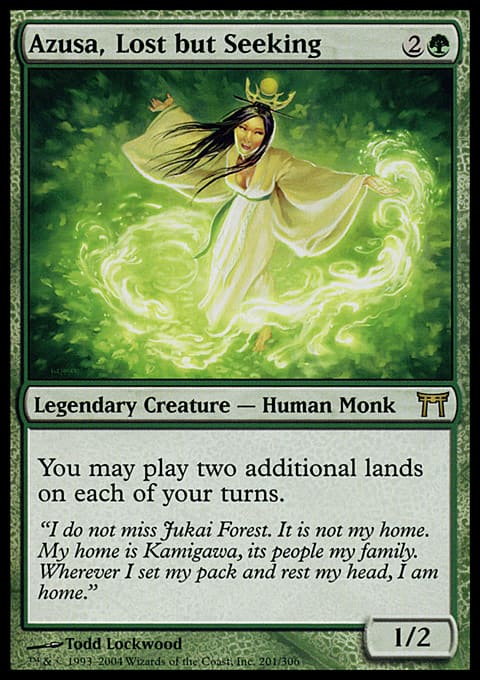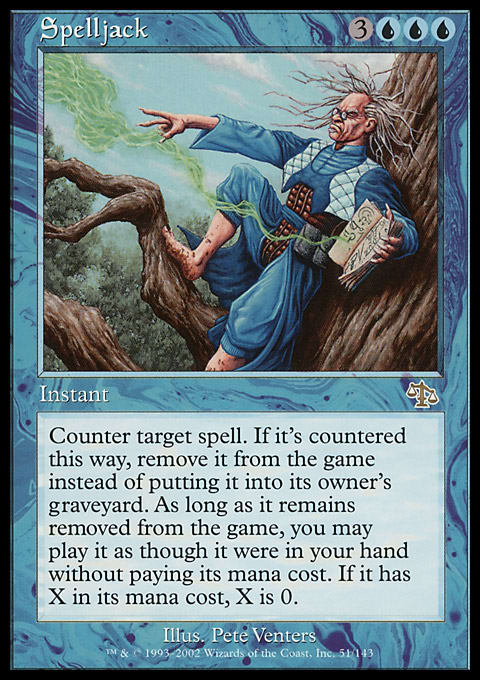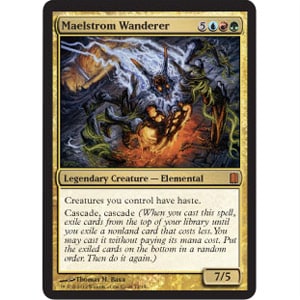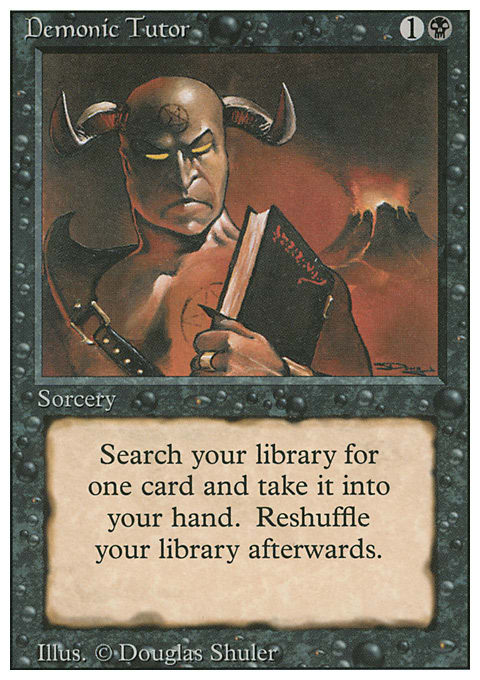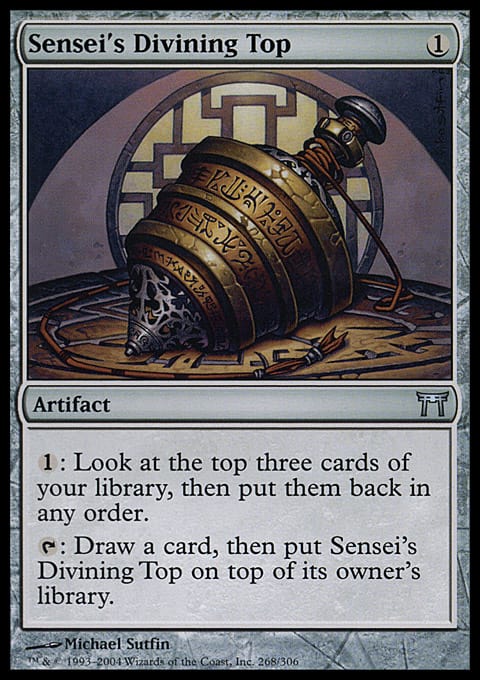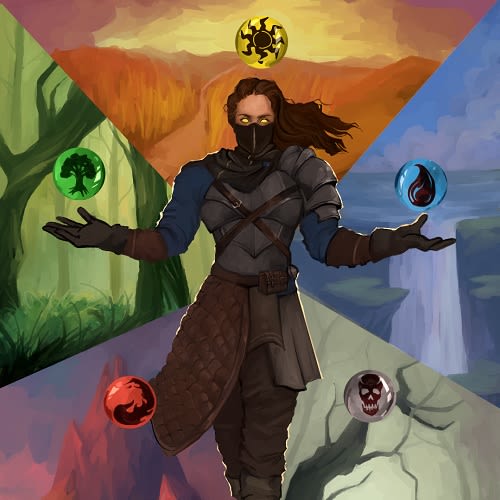Once again, I’d like to thank reddit for its strong positive response to the project and for the veritable deluge of decklist this past week. Car guys like to talk about cars, guitar guys like to talk about their axes, and YuGiOh! players like to talk about their full-sized body pillows with pictures of anime girls on them—it stands to reason that Commander players will love to talk about their Commander decks. I have had more submissions than I had expected, so we have quite a bit of data to look at. Keep them coming—we can never have too many examples.
Very soon after my last article went up, reddit user /u/GhostofEnlil hit me up with his take. I have had the most time to review this one out of all of the submissions, but I think I picked this one first because I think it’s an excellent example, and I want to show a mono-colored deck to demonstrate that even without dipping into other colors for utility, you can still make a good 75% deck without making it too durdly or too oppressive. First, here’s the list.
"Erebos, God of the Dead Decklist"
- Commander (0)
- Creatures (19)
- 1 Abyssal Persecutor
- 1 Crypt Ghast
- 1 Dread
- 1 Grave Titan
- 1 Gray Merchant of Asphodel
- 1 Guiltfeeder
- 1 Ogre Slumlord
- 1 Phyrexian Obliterator
- 1 Reiver Demon
- 1 Shriekmaw
- 1 Skinrender
- 1 Duplicant
- 1 Wurmcoil Engine
- 1 Chainer, Dementia Master
- 1 Drana, Kalastria Bloodchief
- 1 Geth, Lord of the Vault
- 1 Kokusho, the Evening Star
- 1 Korlash, Heir to Blackblade
- 1 Sheoldred, Whispering One
- Planeswalkers (4)
- 1 Liliana of the Dark Realms
- 1 Liliana of the Veil
- 1 Liliana Vess
- 1 Sorin Markov
- Spells (40)
- 1 Geth's Verdict
- 1 Go for the Throat
- 1 Sudden Spoiling
- 1 Tendrils of Corruption
- 1 Ashes to Ashes
- 1 Beseech the Queen
- 1 Corrupt
- 1 Death Cloud
- 1 Demonic Tutor
- 1 Exsanguinate
- 1 Life's Finale
- 1 Phthisis
- 1 Profane Command
- 1 Promise of Power
- 1 Sadistic Sacrament
- 1 Yawgmoth's Will
- 1 Bloodchief Ascension
- 1 Enslave
- 1 Exquisite Blood
- 1 Gate to Phyrexia
- 1 Necropotence
- 1 Painful Quandary
- 1 Phyrexian Arena
- 1 Polluted Bonds
- 1 Underworld Dreams
- 1 Charcoal Diamond
- 1 Darksteel Ingot
- 1 Expedition Map
- 1 Extraplanar Lens
- 1 Lashwrithe
- 1 Lightning Greaves
- 1 Mimic Vat
- 1 Nim Deathmantle
- 1 Oblivion Stone
- 1 Sensei's Divining Top
- 1 Skull of Ramos
- 1 Sol Ring
- 1 Trading Post
- 1 Venser's Journal
- 1 Whip of Erebos
- Lands (36)
- 28 Swamp
- 1 Cabal Coffers
- 1 Mystifying Maze
- 1 Reliquary Tower
- 1 Thawing Glaciers
- 1 Thespian's Stage
- 1 Vesuva
- 1 Urborg, Tomb of Yawgmoth
- 1 Volrath's Stronghold
I had a short conversation with the deck’s architect about what he thought made this a good 75% deck. Let’s see what he had to say.
Name: Shannon Nelson (GhostofEnlil)
How long have you played this deck?
Since Theros came out, so it’s been a few months now. I've had a love of black for a long time, and Erebos was naturally someone I had to have a foil of. Only later did I realize how awesome of a commander he can be.
Is there an existing principle of 75% deck-building this embodies or is there one you think we should create?
The deck has a solid core of cards that are hard for my opponents to interact with such as Dread, Phyrexian Obliterator, and Wurmcoil Engine. The only difference is that I use these cards defensively, sort of as a black pillow fort if that's even a thing. In this sense, my opponents are only affected by them as much as they allow themselves to be, and because I'm not really doing anything with the creatures, their removal is better directed at a bigger threat.
What makes the deck 75% is that I could have easily thrown in some degenerate infinite combos, such as Sanguine Bond with Exquisite Blood or Triskelion with Mikaeus the Unhallowed, but it really doesn't need them outside of cutthroat, competitive play. And although Kokusho, the Evening Star and Chainer, Dementia Master are in the deck, I leave it up to my opponents to decide whether some shenanigans are going to happen between them. I think that really helps balance out the deck, so I can't go into turbo mode on command.
I designed the deck to set a slow, but sure clock on the game, which it maintains astoundingly well through cards like Underworld Dreams, Painful Quandary, and Polluted Bonds. It slowly drains life from other players and uses that life to pay for its own card advantage.
How is this deck received by your group when you play it?
Pretty well, actually—they seem to appreciate the shorter and more manageable games. We have a wide variety of power levels in our group, so it's always interesting to see how people handle my deck because the last thing people want to see after a super-long game is life-gain, so in that sense, Erebos is kind of helping the table.
Are you winning roughly 1 out of every X games, where X is the number of players?
I would say the deck wins 75% of the time, oddly enough. I think a large amount of it has to do with the fact that there isn't really an established power level within our group. Sometimes, people play a silly deck, and sometimes, Kaalia of the Vast wipes the floor with everyone—even after a storm of removal and board wipes.
Did you start with a deck with infinite combos and take cards out to balance it?
My first rendition of the deck was going to feature just Sanguine Bond and Exquisite Blood, but I wanted to play the deck before adding anything that simple to pull off. I think I've only changed a handful of cards since its first version, so I guess you could say it performs as well as it needs to. But like I said before, if our entire group were to ever start becoming cutthroat with each other, I would definitely include some ways to go infinite.
Would you say this deck can beat 100% decks through power or consistency?
Sure. I would probably have to make some minor changes because the deck in its current form is attuned to my group's meta, but I believe it could hold its own against a 100% deck in multiplayer. In one-on-one, maybe not so much—the deck isn't designed for speed. It prefers to play the long game.
Now, Shannon said that he is winning more than 1 ÷ X games with this deck. Is that due to an inherent unfairness with the deck or due to his being in tune with how his playgroup works? The real test is to take this deck blind into a group you’ve never played with before. I think this is a good example, and this will hit closer to the 1 ÷ X mark with a new group.
The other reservation is that we don’t want a deck that was built more optimally and then weakened: essentially, built backward. It’s better to start with a 50% deck and make it better than it is to start with a 100% deck and make it weaker—there will be too many cards that synergize with stronger cards and that do almost nothing when the deck is weakened. I don’t think that by neglecting to put a combo of Sanguine Bond and Exquisite Blood in the deck that Shannon “weakened” it, and I feel that this was built from the bottom up and that certain elements that would take this to closer to 100% were omitted to keep things fun.
So, what makes this a good 75% deck, and what can we learn about 75% decks in general?
One thing that struck me about this build was that it seems tailored toward keeping things even. There are two classes of card that do this in the deck. The first class of card seeks to injure all opponents in a small and manageable, yet reliable and tangible way. Exsanguinate, Painful Quandary, Polluted Bonds, Underworld Dreams, Sheoldred, Whispering One, and Death Cloud: All of these cards hit everyone. The best among them in my view punish your opponents for doing things. They don’t kill them or make them go away or stop them from playing them; rather, they “tax” them. Painful Quandary doesn’t blow up lands or take away creatures; what it does is make players make tough choices and sometimes choose to develop their boards a little less, giving you an advantage. Polluted Bonds does not destroy their lands—something that feels bad, especially to casual players. What it does is force players to decide whether they really need those land drops, and it punishes them a bit if they decide they do. I am a big fan of these universal taxation elements.
The other class of spells hurts one player in particular. Sadistic Sacrament, Life's Finale, Phthisis, Profane Command, basically all of the spot removal, and Sorin Markov: These spells all stop someone who is ahead from pulling further ahead. Life's Finale is a great example of this because it hits every player but hits one player even harder in particular. This allows the card to be played diplomatically despite it being, at heart, just an expensive Damnation. Players won’t appreciate the board wipe, but they may appreciate you not Jester's Capping them while you’re at it. Where Exsanguinate will cheese off the table, Corrupt will cheese off one person. It’s important to have some cards that will make an enemy of everyone and some cards that will cause you to make a mortal enemy of one person. Multiplayer formats are political, and I think both classes of spell are important.
A marvelous card for 75% decks that I hadn’t considered a 75% card before is Sorin Markov. While Sheldon Menery included it in his list of cards he would ban if he had to, I think Sorin Markov is among the best 75% cards ever. On its face, it looks super-unfair. So, why would I consider this a 75% card? The answer lies in the politics of Commander.
A Brief Aside
A group of Spikey players with powerful decks is more inclined to play the card as written. “Okay, the card says a player’s life total becomes 10. Which one of us are you targeting?” These players have powerful effects in their decks—such a player can take the heat and play a game at 10 life, and he or she will do equally powerful stuff. Spikey players are less inclined to let you take back plays, and they want to adhere to the rules. In a tournament setting, such as at a side event at a Grand Prix, the ruling will be the card is played as written.
Conversely, more casual groups will look at the card and want to play it as intended. Such players will look at it and say, “Well, look, this card was intended for a 20-life format, and since this is a 40-life format, we think it should make someone’s life total 20—half the player’s starting total, just like in sixty-card.” They probably already have a rule in place, and if they don’t, they will now! Infect, Magister Sphinx—all of these effects are likely to be scaled based on the format by a group of more casual players. That makes something like Sorin, a card that seems oppressive, actually a very good 75% card because, while it doesn’t inherently scale based on the group, special rules each group has will scale the card’s effect for you. Put it to a vote when you play it! Maybe Sorin doesn’t need a ban after all.
What Can We Learn?
I think what I like best about this deck is the taxation effects. They don’t hurt newer players disproportionately; in fact, a “trickier” deck with bounce lands, Crucible of Worlds, Azusa, Lost but Seeking and Oralce of Mul Daya, and the like is going to feel the pinch from Polluted Bonds more than a guy windmilling Vivid Creeks and Seaside Citadels. I think Corruption, Sinkhole, and the like are poor 75% choices because no one likes land destruction. Allowing players to develop as they would but punishing them a bit is a nice way to make things a little fairer and make the games a little shorter. I imagine different play groups would have an easier time solving this deck and that it would run closer to the 1 ÷ X win rate I desire without weakening the deck too much.
In fact, I like the “taxation” principle so much I think we can add it to our list of principles.
- Scalable spells help tailor your cards to the power level of your opponents' decks.
- Always start weak and improve the deck—never weaken a better deck.
- You can skew toward power provided you skew away from consistency.
Let’s add to it:
- It is better to punish everyone equally for doing something rather than prevent them from doing it.
I think counterspells make Commander kind of boring unless they have other uses—like my Spelljack and Plasm Capture for helping me free-roll my Maelstrom Wanderer to generate more triggers. It’s much better to give a player damage or make him or her sacrifice something for playing a creature than prevent the player from doing it. I like how our list of principles is shaping up.
If I could make some minor tweaks to this deck, I would take out Sensei's Divining Top and Demonic Tutor. These add consistency to the deck, and I think it’s better to take away consistency and skew more powerful than it is to reduce power and skew more consistent. Sensei's Divining Top is a card I took out of all of my decks because I couldn’t stop Topping like a Legacy player. I was Topping on every upkeep to stash a card I thought was more useful on a given player’s turn. Don’t make everyone watch you waste their time. Demonic Tutor is a card that has no other use than making everyone watch you do something sneaky and powerful. Unlike Worldly Tutor or Pattern of Rebirth or the other tutors whose uses I defended, Demonic Tutor can’t be used to save your bacon or as a deterrent. It merely slows the game down, and removing it will not lower the power level of the deck, but merely its consistency, and I think removing consistency does not violate my principle of “don’t make a deck 75% by making a better deck weaker.” You could even add something powerful like Damnation in place of the tutor, and the deck will still be a fine 75% example. I’d lose the Tutor and Top. To replace the Top, I’d add a copy of Greed. It’s redundant with Erebos, but it’s less mana-intensive and is less likely to be destroyed or tucked, and I think drawing cards is a way to make sure you get what you need, but it takes half a second rather than half a minute.
That does it for this installment. I have quite a few submissions to wade through, but that doesn’t mean I don’t want more! E-mail me at altjason17 at gmail dot com, find me on reddit, or hit me up on Twitter @JasonEAlt. Every deck we see teaches us a lesson about how to make our own 75% deck from the ground up, so let’s look at a few more examples. Until next time.















